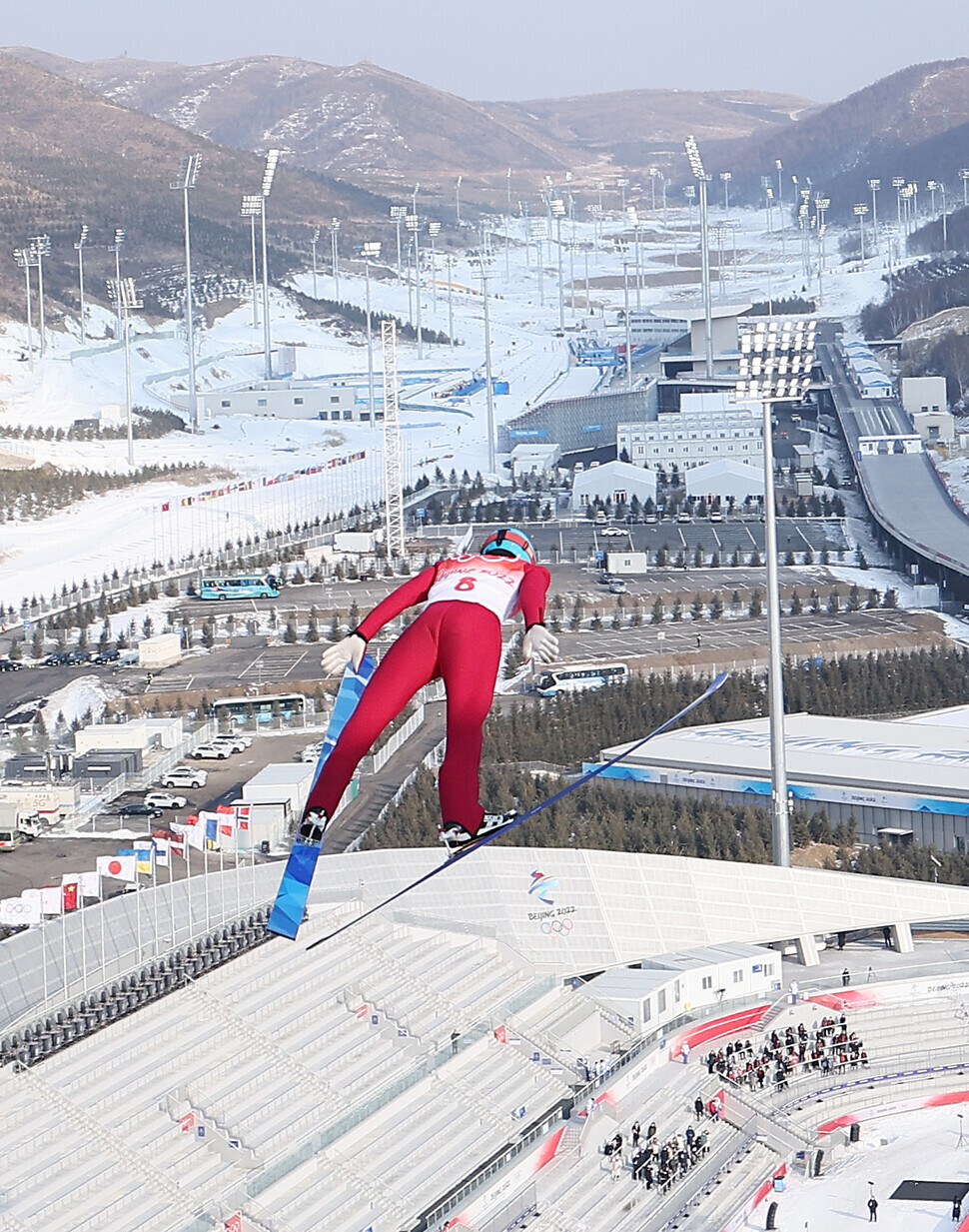hankyoreh
Links to other country sites 다른 나라 사이트 링크
The snow in Zhangjiakou is a show of climate woe

The 2022 Winter Olympics in Beijing, which are currently about halfway through, are the first in history to be held entirely with artificial snow.
It’s part of a vicious cycle: because of climate change, the Olympics can’t be held without artificial snow, but the massive amounts of water and electricity used to produce it only exacerbate climate change.
The 2014 Winter Olympics in Sochi were plagued by unusually high temperatures, resulting in an 80% reliance on artificial snow. At the 2018 Winter Olympics in Pyeongchang, 90% of the snow was artificial.
The first Winter Olympics to make use of artificial snow and ice was the 1964 event in Innsbruck. A lack of snowfall prompted host nation Austria to mobilize its military to fly in 20,000 ice blocks and 40,000 cubic meters of snow for the arena.
The first use of machine-made snow came in 1980 with the Winter Olympics in Lake Placid.
Producing snow artificially entails huge financial and environmental costs. To make snow for the latest Winter Olympics, China spent the equivalent of 2 trillion won and used 185 million liters of water — enough for 100 million people to drink in a day.
The Chinese government says it plans to thaw and reuse the snow after the Olympics, but experts predicted that around 40% would be lost to evaporation.

Scientists noted the difference between natural and artificial snow.
President Joe VanderKelen of Snow Machines Inc., which supplied snow for the Sochi and Pyeongchang Games, stressed to the US website Vox that machine-made snow is “not artificial snow; it’s real snow.”
But Ken Libbrecht, a professor at the California Institute of Technology, said the term “artificial snow” was scientifically accurate.
To produce artificial snow, a machine combines water with compressed air and ejects the mixture at an angle. The water freezes as it descends, transforming into its white snowy form on the slope.
Natural snow, in contrast, starts from tiny droplets of water measuring a few micrometers across. It serves as a core to which dust and other particles in the air attach as the snow is formed.
It takes about an hour for a snowflake to form as that core absorbs water vapor from the air, growing outward into a perfectly symmetrical fractal — a geometric shape in which the overall form can be observed in the different parts when broken down.
The difference between the two forms of snow is clearly apparent under a microscope. Artificial snow doesn’t look like flakes — it looks more like pellets. Also, while the machine-made snow is 30% ice and 70% air, the natural snow is 10% ice and 90% air.
Jessica Murfree, a professor at Texas A&M University, noted that while snow machines have become more popular amid the effects of climate change, they could exacerbate the problem with their huge electrical pull.
She also warned that the huge costs of making snow could result in higher prices for winter sports, making snow sports — already considered elitist by many — even more unequal.
By Lee Keun-young, staff reporter
Please direct questions or comments to [english@hani.co.kr]

Editorial・opinion
![[Column] When ‘fairness’ means hate and violence [Column] When ‘fairness’ means hate and violence](https://flexible.img.hani.co.kr/flexible/normal/500/300/imgdb/original/2024/0516/7417158465908824.jpg) [Column] When ‘fairness’ means hate and violence
[Column] When ‘fairness’ means hate and violence![[Editorial] Yoon must stop abusing authority to shield himself from investigation [Editorial] Yoon must stop abusing authority to shield himself from investigation](https://flexible.img.hani.co.kr/flexible/normal/500/300/imgdb/original/2024/0516/4417158464854198.jpg) [Editorial] Yoon must stop abusing authority to shield himself from investigation
[Editorial] Yoon must stop abusing authority to shield himself from investigation- [Column] US troop withdrawal from Korea could be the Acheson Line all over
- [Column] How to win back readers who’ve turned to YouTube for news
- [Column] Welcome to the president’s pity party
- [Editorial] Korea must respond firmly to Japan’s attempt to usurp Line
- [Editorial] Transfers of prosecutors investigating Korea’s first lady send chilling message
- [Column] Will Seoul’s ties with Moscow really recover on their own?
- [Column] Samsung’s ‘lost decade’ and Lee Jae-yong’s mismatched chopsticks
- [Correspondent’s column] The real reason the US is worried about Chinese ‘overcapacity’
Most viewed articles
- 1China calls US tariffs ‘madness,’ warns of full-on trade conflict
- 2[Column] US troop withdrawal from Korea could be the Acheson Line all over
- 3[Editorial] Yoon must stop abusing authority to shield himself from investigation
- 4[Column] When ‘fairness’ means hate and violence
- 5[Column] How to win back readers who’ve turned to YouTube for news
- 6US has always pulled troops from Korea unilaterally — is Yoon prepared for it to happen again?
- 7[Book review] Who said Asians can’t make some good trouble?
- 8Naver’s union calls for action from government over possible Japanese buyout of Line
- 9Could Korea’s Naver lose control of Line to Japan?
- 10[Editorial] Korea must respond firmly to Japan’s attempt to usurp Line